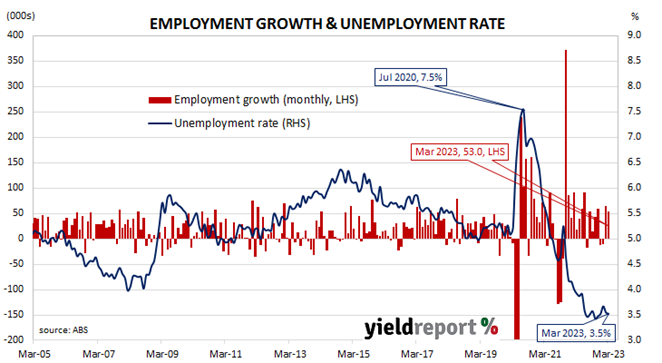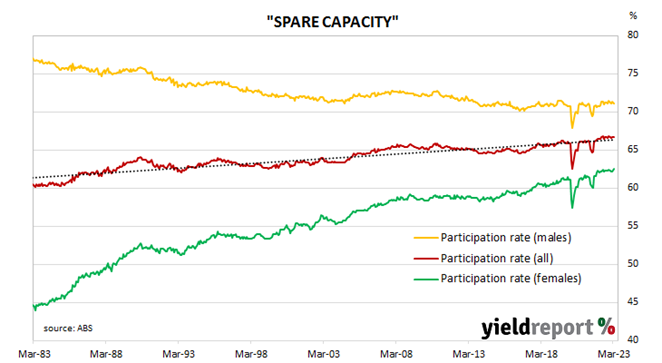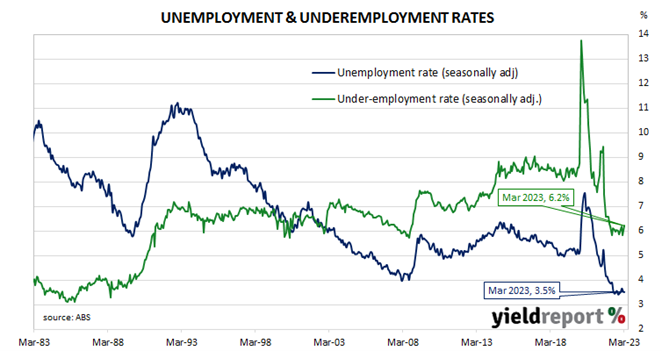Summary: Employment up 53,000 in March, greater than expected; Westpac: appetite for new workers remains robust; ANZ: excess labour demand persists; participation rate steady at 66.7%; jobless rate steady at 3.5%; fewer part-time, more full-time jobs; aggregate work hours down 0.2%; underemployment rate rises to 6.2%.
Australia’s period of falling unemployment came to an end in early 2019 when the jobless rate hit a low of 4.9%. It then averaged around 5.2% through to March 2020, bouncing around in a range from 5.1% to 5.3%. Leading indicators such as ANZ’s Job Ads survey and NAB’s capacity utilisation estimate suggested the unemployment rate would rise in the June 2020 quarter and it did so, sharply. The jobless rate peaked in July 2020 but fell below 7% a month later and then trended lower through 2021 and 2022.
The latest Labour force figures have now been released and they indicate the number of people employed in Australia according to ABS definitions increased by 53,000 in March. The rise was greater than the 20,000 increase which had been generally expected but less than February’s 63,600 gain after revisions.
“Businesses’ appetite for new workers remains robust, in line with the growth in labour supply, but we continue to expect labour market outcomes will soften more clearly into the second half of this year,” said Westpac senior economist Justin Smirk.
Domestic Treasury bond yields generally increased on the day. By the close of business, the 3-year ACGB yield had gained 4bps to 2.91%, the 10-year yield had added 3bps to 3.27% while the 20-year yield finished unchanged at 3.67%.
In the cash futures market, expectations regarding future rate cuts softened. At the end of the day, contracts implied the cash rate would rise from the current rate of 3.57% to average 3.62% in May and then decline to an average of 3.655% in August. November contracts implied a 3.56% average cash rate while May 2024 contracts implied 3.34%, 23bps below the current cash rate.
ANZ senior economist Catherine Birch sounded more positive than her Westpac counterpart. “Leading indicators like ANZ-Indeed Job Ads, ABS job vacancies and NAB’s employment index are off their peaks but still elevated, signalling excess labour demand persists. This and strong migration will continue to support employment growth.”
The participation rate remained steady at 66.7% after revisions as the total available workforce increased by 51,400 to 14.391 million while the number of unemployed persons decreased by 1,600 to 507,000. As a result, the unemployment rate remained unchanged at 3.5% after rounding.
The aggregate number of hours worked across the Australian economy decreased by 0.2% even as 19,200 residents lost part-time positions and 72,300 residents gained full-time positions. On a 12-month basis and after revisions, aggregate hours worked increased by 5.5% as 22,400 more people held part-time positions and 375,700 more people held full-time positions than in March 2022.
In recent years, more attention has been paid to the underemployment rate, which is the number of people in work but who wish to work more hours than they do currently. March’s underemployment rate fell from January’s rate of 5.8% to 6.2%, 0.4 percentage points above this cycle’s low.
The underutilisation rate, that is the sum of the underemployment rate and the unemployment rate, has a strong correlation with the annual growth rate of the ABS private sector wage index when advanced by two quarters. March’s underutilisation rate of 9.7% corresponds with an annual growth rate of about 4.4%.




